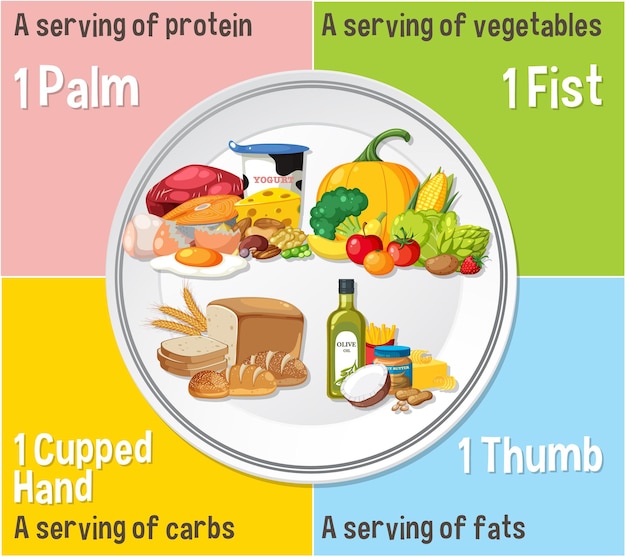Food as Medicine: Impact of Dietary Guidelines on Health

Food as medicine explores how current dietary guidelines influence health outcomes by emphasizing nutrition’s role in disease prevention and management.
The concept of food as medicine: exploring the current dietary guidelines and their impact on health isn’t new, but it’s rapidly gaining traction as we understand more about the profound impact of diet on our overall well-being.
Understanding the Principles of Food as Medicine
Food as medicine is a philosophy that emphasizes the use of food to prevent, manage, and even reverse diseases. It recognizes that what we eat is foundational to our health and well-being.
This approach integrates the principles of nutrition science with traditional knowledge and culinary practices. It’s about understanding how different foods affect our bodies at a cellular level and making informed choices to support optimal health.

The Core Tenets of Food as Medicine
Several key principles underpin the concept of using food as medicine.
- Nutrient Density: Prioritizing foods rich in vitamins, minerals, and antioxidants.
- Whole Foods: Focusing on unprocessed, natural foods.
- Personalization: Recognizing that dietary needs vary from person to person.
- Balance: Ensuring a balanced intake of macronutrients (proteins, carbohydrates, and fats).
By adhering to these principles, individuals can harness the healing power of food and make significant strides in improving their health outcomes.
In essence, food as medicine empowers individuals to take an active role in their health by making conscious and informed dietary choices.
Current Dietary Guidelines: An Overview
Current dietary guidelines in the U.S. are established by the U.S. Department of Agriculture (USDA) and the Department of Health and Human Services (HHS). These guidelines are updated every five years to reflect the latest scientific evidence.
They provide recommendations for healthy eating patterns across the lifespan, from infancy to older adulthood. The guidelines are intended to help Americans make informed choices about what to eat and drink to reduce the risk of chronic diseases.
Key Recommendations from the Dietary Guidelines
The dietary guidelines include several key recommendations for creating a healthy eating pattern.
- Variety: Eat a variety of vegetables, fruits, grains, protein foods, and dairy.
- Nutrient Density: Choose nutrient-dense foods and beverages.
- Limiting Added Sugars, Saturated Fats, and Sodium: Consume these in moderation.
- Portion Control: Be mindful of portion sizes to maintain a healthy weight.
These recommendations are designed to be flexible and adaptable to individual needs and preferences. They emphasize the importance of making small, sustainable changes over time.

Ultimately, the dietary guidelines provide a framework for promoting health and preventing chronic diseases through informed food choices.
The Impact of Dietary Guidelines on Public Health
The dietary guidelines play a crucial role in shaping public health initiatives and policies in the U.S. They influence everything from school lunch programs to food labeling regulations.
By translating scientific evidence into practical recommendations, the guidelines help healthcare professionals, educators, and policymakers promote healthy eating habits among the general population.
How Dietary Guidelines Shape Public Health Policies
The dietary guidelines serve as the foundation for numerous public health policies and programs.
- National School Lunch Program: Ensuring that school meals meet specific nutritional standards.
- Supplemental Nutrition Assistance Program (SNAP): Providing food assistance to low-income individuals and families.
- Food Labeling Regulations: Requiring food manufacturers to provide clear and accurate nutrition information.
These policies and programs are essential for addressing health disparities and promoting equitable access to nutritious food for all Americans.
The dietary guidelines provide a science-based framework for creating healthier communities and improving the overall health of the nation.
Bridging the Gap: Implementing Food as Medicine in Daily Life
While the dietary guidelines offer a comprehensive framework for healthy eating, implementing the principles of food as medicine in daily life requires a more personalized and holistic approach.
It involves understanding your individual nutritional needs, making conscious food choices, and adopting sustainable eating habits that support long-term health and well-being.
Practical Strategies for Incorporating Food as Medicine
There are several practical strategies that individuals can use to incorporate the principles of food as medicine into their daily lives.
- Meal Planning: Plan your meals in advance to ensure you’re eating a variety of nutrient-dense foods.
- Cooking at Home: Preparing your own meals allows you to control the ingredients and portion sizes.
- Mindful Eating: Pay attention to your hunger and fullness cues and savor each bite.
- Experimenting with New Recipes: Try new recipes that feature whole, unprocessed foods.
By adopting these strategies, individuals can transform their relationship with food and harness its healing power.
Ultimately, implementing food as medicine is about making informed choices and adopting sustainable eating habits that support overall health and well-being.
The Role of Healthcare Professionals in Promoting Food as Medicine
Healthcare professionals play a critical role in promoting the concept of food as medicine and helping patients make informed dietary choices.
Registered dietitians, nutritionists, and other healthcare providers can provide personalized nutrition counseling, develop meal plans, and educate patients about the importance of healthy eating.
How Healthcare Professionals Can Integrate Food as Medicine
Healthcare professionals can integrate the principles of food as medicine into their practices in several ways.
- Nutrition Counseling: Providing individualized nutrition assessments and recommendations.
- Meal Planning: Developing meal plans tailored to specific health conditions.
- Group Education: Conducting workshops and seminars on healthy eating.
- Collaboration: Working with other healthcare providers to offer comprehensive care.
By integrating food as medicine into their practices, healthcare professionals can empower patients to take an active role in their health and well-being.
The integration of food as medicine in healthcare settings is essential for promoting health and preventing chronic diseases.
Challenges and Opportunities in the Food as Medicine Movement
While the food as medicine movement is gaining momentum, there are several challenges and opportunities that need to be addressed to ensure its continued growth and success.
These include addressing food insecurity, promoting nutrition education, and advocating for policies that support healthy eating.
Addressing Food Insecurity and Promoting Nutrition Education
Addressing food insecurity and promoting nutrition education are critical for ensuring that all individuals have access to nutritious food and the knowledge to make informed dietary choices.
- Food Banks and Pantries: Supporting organizations that provide food assistance to those in need.
- Community Gardens: Creating spaces for individuals to grow their own food.
- Nutrition Education Programs: Providing education on healthy eating and cooking skills.
By addressing these challenges, we can create a more equitable and sustainable food system that supports the health and well-being of all members of society.
| Key Point | Brief Description |
|---|---|
| 🍎 Nutrient Density | Prioritize foods rich in vitamins and minerals for better health. |
| 🥦 Whole Foods | Focus on unprocessed, natural foods for optimal nutrition. |
| 🥗 Balance | Ensure a balanced intake of proteins, carbs, and fats. |
| 🧑⚕️ Healthcare Role | Healthcare pros educate and guide personalized nutrition. |
Frequently Asked Questions
▼
Food as medicine refers to using dietary choices to prevent, manage, or treat illnesses. It acknowledges the powerful role that nutrition plays in maintaining optimal health and well-being.
▼
Dietary guidelines shape public health by informing policies, programs, and educational initiatives. These guidelines aim to promote healthy eating patterns and reduce the risk of chronic diseases across the population.
▼
Key recommendations include eating a variety of nutrient-dense foods, limiting added sugars, saturated fats, and sodium, and practicing mindful portion control. Prioritizing whole, unprocessed foods is also essential.
▼
Incorporate food as medicine by planning meals, cooking at home using whole ingredients, practicing mindful eating, and experimenting with healthy recipes. Understanding your body’s needs is also crucial.
▼
Healthcare professionals educate and guide people with personalized nutrition assessments, meal plans, and counseling. Their role is helping to integrate food as medicine into the treatment protocols.
Conclusion
Throughout this exploration of food as medicine: exploring the current dietary guidelines and their impact on health, it’s clear that our dietary choices deeply affect our well-being. By understanding and implementing the principles into our daily lives, we can transform our health and prevent diseases.
